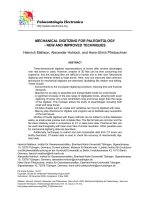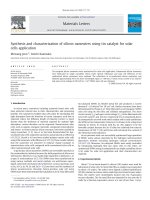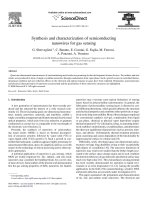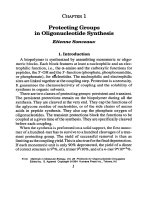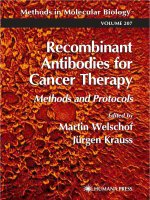Protocols for oligonucleotide conjugates synthesis and analytical techniques
Bạn đang xem bản rút gọn của tài liệu. Xem và tải ngay bản đầy đủ của tài liệu tại đây (19.44 MB, 372 trang )
Protecting Groups
in Oligonucleotide
Synthesis
Etienne Sonveaux
1. Introduction
A biopolymer is synthesized by assembling monomeric or oligomerit blocks. Each block features at least a nucleophilic and an electrophilic function, i.e., the a-amino and the carboxylic functions for
peptides, the S-OH and the 3’-function (phosphate, phosphoramidite,
or phosphonate), for n&leotides. The nucleophilic and electrophilic
sites are linked together at the coupling step. Protection is a necessity.
It guarantees the chemoselectivity of coupling and the solubility of
synthons in organic solvents.
There are two classes of protecting groups: persistent and transient.
The persistent protections remain on the biopolymer during all the
synthesis. They are cleaved at the very end. They cap the functions of
the aglycone residue of nucleotides, or of the side chains of amino
acids in peptide synthesis. They also cap the phosphate oxygen of
oligonucleotides. The transient protections block the functions to be
coupled at a given time of the synthesis. They are specifically cleaved
before each coupling.
When the synthesis is performed on a solid support, the first monomer of a hundred-mer has to survive to a hundred cleavages of a transient protecting group. The yield of successful removal is thus as
limiting asthe coupling yield. This is also true for the final deprotection.
If each monomeric unit is only 90% deprotected, the yield of a dimer
of correct structure is g2%, of a trimer g3/10%, and of a n-mer 9V10”-2%.
From
Methods
m Molecular
Edited by. S. Agrawal
Biology, Vol. 26 Protocols for O//gonuc/eot/de
Conpgates
CopyrIght
01994
Humana Press Inc., Totowa, NJ
1
2
Sonveaux
Yields drop dramatically with length. Paradoxically, the crucial problem of protection is thus deprotection. Good results obtained with a
protection strategy on small sequencesdo not guaranteethat the method
is viable. The discriminating test is the successin obtaining high yields
of long oligomers.
In oligonucleotide synthesis, the academic research is nowadays
moving from DNA synthesis to the synthesis of RNA and modified
DNA/RNA structures. As functions and types of aglycone residues
entering oligonucleotide synthesis diversify, protection strategies have
to be adapted. That is why this review may be useful.
Its content is as follows. The persistent protections of the nucleic
basesand of the 2’-OH of ribonucleotides are considered first. Both are
usually introduced at the beginning of the synthesis. The transient
protection of the S-OH is then discussed. This function is indeed
capped before the phosphorylation or phosphitylation of the synthons.
The last paragraph describes the protections of phosphorus. This last
topic is much related to coupling strategies. The reader is thus invited
to consult the other parts of this book to embrace the whole field.
2. Protection
of the Heterocyclic
Bases
and Protocols for Oligonucleotides
and Analogs
The protecting groups that have been proposed for the aglycone
residues are presented in Tables 1-5. The most useful protections are
briefly described in the following paragraphs.
2.1, Thymidine
and
Uridine
It is possible to synthesize oligo DNA or RNA by one of the three
classical methods (phosphotriester, phosphoramidite, phosphonate
stategies) without protecting these residues. However, the N-3 nitrogen being acidic (T, pK, = 9.79) (I), a certain amount of the anionic
form is present in basic media. In these conditions, the thymine and
uracil residues react with electrophiles like alkylating agents (2,3)
(inter alia, the methyl phosphate of the internucleotidic bond in one of
thephosphoramidite strategies(3-5), carbodiimides (6), activatedphosphates (7-14) and sulfonates (15,16), bis(diisopropylamino) methoxyphosphine (I7), trimethylsilyl chloride (18), and acid chlorides.
www.pdfgrip.com
Protecting Groups in Synthesis
3
The instable O-4 phosphorylated products undergo a nucleophilic
attack on C-4 by nucleophiles usually present in the medium, like 1,2,4triazole, 3-nitro-1,2,4-triazole, l-hydroxybenzotriazole, N-methylimidazole or pyridine. In the case of acylation, the N-3 acylated derivative
is usually obtained (19). It is the thermodynamic product. The O-4
acylated derivative, accessible by PTC, spontaneously rearranges to
the N-3 acylated isomer (16).
In the conditions of a normal oligonucleotide synthesis, the contact
times with electrophiles are short and these side reactions are limited
(20). Thyrnidine is less sensitive than uridine (15), and is usually not
protected (21). Some side reactions are reversed (17), either during synthesis, or by an adequatefinal deprotection (15,22) (e.g., oximate). The
side reactions of uracil in phosphotriester synthesis may be a serious
nuisance (22). They have been carefully studied by Reese(7,15,23,24).
Two protecting groups are well established: the N-3 anisoyl and the
4-(2,4-dimethylphenyloxy) derivatives I and 4 (Table 1).
The N-3 anisoyl compound is a little more resistant to nucleophilic
attack than the N-3 benzoyl(2526). It is introduced, by PTC (16) or
in homogeneous conditions (27) (See also ref. 28), by selective N-3
acylation of 3’,5’-0-( 1,1,3,3-tetraisopropyldisiloxane-1,3-diyl)uridine,
followed by the protection of the 2’-OH and desilylation. The 2’-O(tetrahydropyran-2-yl)-3’,5’-O-( 1,1,3,3-tetraisopropyldisiloxane- 1,3diyl)uridine is also easily anisoylable on N-3 (29). The selective N-3
acylation is possible by the so called Jones’ method (in situ protection
of the 5’,3’, and 2’-0 by trimethylsilyl chloride during acylation, followed by the hydrolysis of the silyl ethers in the workup) (26,28,30).
Protection 4 is introduced by reaction of 2’-0-(4-methoxytetrahydropyran-4-yl)-3’,5’-0-dimethoxyacetyluridine
with diphenylphosphochloridate and 3-nitro- 1,2,4-triazole in pyridine, followed by a
treatment with a phenol and triethylamine. The labile 3’ and 5’-0 acyl
groups are cleaved by 8M ammonia in methanol (23). Care is needed
because this type of uracil protection may be substituted by ammonia
to give cytosine (31,32).
2.2. Cytidine
and Deoxycytidine
These nucleosides are usually protected by acylation on N-4. Cytosine is the most basic of the aglycone residues (dC, pK, = 4.25). It is
also the most nucleophilic. The rate of acylation decreasesin the order:
C(N-4) > OH > A(N-6) > G(N-2) (52).
www.pdfgrip.com
4
1.
2.
3.
4.
5.
6.
7.
8.
9.
10
11.
Sonveaux
Table 1
Protections of Thymine and Uracil Residuesa
Properties of the tabulated protecting groups
(solvent mixtures are expressed in volumic proportions)
Resists to K&O3 0.2M (short time); TBAF lM/THF; chromatography on silica
(CHCl&HsOH);
NEts/pyridine. It 1s cleaved by NH, cc in CH,OH/H,O;
n-butylamine
0 04MICHsOH;
TBAF/pyridine/HzO
(8*1:1). See refs.
25,26,28,29,33-35.
Resists to CHsCOOH 80% (2 h); TBAF/THF; ZnBrz lM, pyndinelt-butylamine/
Hz0 (8:l:l) (24 h). It is cleaved by cont. NI-Is in CHsOH (9:l) (T,., 3 h). See refs.
36,37.
Resists to t-butylamine 0.14WCHsOH (20 min). It is cleaved by Znlpyndine.
See refs 16,38,39.
Resists to K&JO3 0.2M, morpholme 0 05M, NH3 8MICHsOH (~15 mm). It is
cleaved by oximate. See refs. 23,24,40.
Is cleaved by oximate. See refs. 31,41.
Resists to NHs/CHsOH. It is cleaved by DBU OSMlpyridine. See refs 42,43,45
For possible side reactions involving the 0-Calkylthymme residues, see ref. 44.
Resists to CHsCOOH 80%, cont. NHs/CHsOH. It is cleaved by I, O.lM/THF/
collidine&O.
See refs 16,46.
Resists to CHsCOOH 80%. It is cleaved by pyridine/H,O; TBAF 0 2MTHF
See ref. 47.
Resists to CHsCOOH 80%; HCl pH 2; oximate; NaOH 0.2M. It is cleaved by
NH3 cc/pyridine. (50°C) (C6Hs),C+ BFJ-Does not cleave well. See refs. 28,48,49.
Resists to NH2-NH2 1M in pyridine/CH$OOH
(3: 1). It is cleaved by cont. NH,
See ref. 50.
Resists to cont. NH,; DBU OSWpyridine (1 h); TBAF 1M: THF. It is cleaved
by cont. NHs, 50°C (2.5 h) See refs. 21,51.
?Yeeopposite page for corresponding structure.
It is possible to specifically acylate the exocyclic amino function of
cytidine or deoxycytidine, under controlled conditions: activated esters
(53,54), acid anhydrides (55,56), some acid chlorides (57), mixed anhydrides (58), l-alkyloxycarbonylbenzotriazoles (43,59), carboxylic acids
activated by EEDQ(60) and thioacetic acid (61,62) have been used for
this purpose.
The rate of N-deacylation by ammonia or sodium hydroxyde decreases
in the order C > A > G (63-69) (acylated adenineand guanine residues of
nucleosides may loose a proton in basic media, rendering them more
resistant to nucleophilic attack). It is to be noticed that nucleophiles may
attack on C-4, displacing the acylated nitrogen. The N-4 acylcytosine
residueis deaminatedto thecorrespondinguracil by hot acetic acid (70,71).
Similarly, n-butylamine gives the N-4-butyl derivative (72).
www.pdfgrip.com
Protecting Groups in Synthesis
5
Table 1
Structures
R=H,CH,
Ar=-(=J,
-@b
R=H,CH3
r@m3
R=H,CH,
K!
a
u
0
NO
R=H,CH,
I
www.pdfgrip.com
6
Sonveaux
As a result of easy deacylation under acidic or basic catalysis, the
protection of cytidine and deoxycytidine need some tuning. The haloacetyl groups are useless, being to labiles (73). The N-4 acetyl protection is fragile(68,73,74), (HCl 0. lM, tii2 = 2 h; KOH O.OlM, tiiZ = 6 h;
NaOH 0.2M/CH30H (1: l), RT, tu2 = 0.2 min; cont. NH,/C,HSOH
(1: l), RT, t1,2= 10 min). It is cleaved by boiling ethanol (61). The pmethoxybenzoyl group, more resistant to nucleophilic attack, was
formerly used with the phosphodiester method (75). The most resistent
acyl group is o,p-dimethylbenzoyl (68). The benzoyl group is routinely used nowadays, although it is less robust (70) (e.g., deacylation
of the 2’, 3’ or 5’ 0-silylated derivatives by methanol; refs. 76,77);
deacylation by hydrazine in pyridine/acetic acid (78). It is cleaved
without problems by ammonia at room temperature (66) (NH3 9M, t,,
= 16 min (70); NH3 5iWdioxane (1: l), complete cleavage in 6.5
&63); NH, 29%/pyridine (80:20), tu2 = 2 h (64,6.5).
On a preparative point of view, the acylation method of Jones-SungNarang (in situ protection of the alcohol functions by trimethylsilyl
chloride) (I#, 79) is particularly practical. It is also possible to ZV,Operacylate the nucleoside and to selectively cleave the ester functions
afterwards (23,71). Deoxycytidine has been selectively ZV-4-benzoylated on a multikilogram scale by simply shaking the nucleoside with
one equivalent of benzoic anhydride in DMF (56). If a more easily
cleavable protection is necessary, one would prefer theZV-4-isobutyryl
group (64,65) (cleaved by ammonia 28%, RT, 5 h) (80,81)
2.3. Adenosine and Deoxyadenosine
The protection of these nucleotides requires a special comment,
because the chemical stability of the nucleoside is altered by the protection of the exocyclic amino function of the nucleic base. The discussion thus starts with an account of the encountered problems.
2.3.1. Stability
Toward Acids
Purine nucleosides can loose their purine residue in acidic conditions, leaving an unsubstituted sugar (apurinic site). This reaction is a
nuisance because oligonucleotides are repeatedly submitted to acid
detritylation during routine synthesis on a solid support.
The mechanism of acid depurination involves a rapid preequilibrium
of protonation (or deprotonation) of the purine residue, followed by
www.pdfgrip.com
Protecting Groups in Synthesis
1.
2.
3a.
3b.
3c.
3d
3e.
4
5
6.
7.
8.
9
10
11.
12.
13.
14.
15
16.
17.
7
Table 2
Protections on N-4 of the Cytosine Residuea
List of methods of cleavage and relevant references
(solvent mixtures are expressed in volumlc proportions)
Cont. NHs, TY Refs. 56,60,74.
Cont. NH,, TV Refs 64,65,80.
Cont. NH,, Tp Refs 14,56,60,71,79. This protection is selectively removed by
NH2-NH2 in pyridine/acetic acid (4.1) Refs. 150-1.52
Cont. NHs, T, Ref. 23.
Cone NH,, TV Refs. 60,71,82.
Cont. NH,, 50% Ref 68.
Cone NHs, 50°C Ref. 57.
Cone NH,, 50°C Ref. 83.
TBAF/pyridine/H,O
(1: 1) Ref 84.
K&O:, O.OSM/CH,OH, T, or cont. NHs, T, Ref 85
NH2-NH2 0 SM/pyridine/CH&OOH
(4: 1) Ref. 86
Cone NH,, T, Ref 78.
NEtdpyridine or oxrmate. Refs 63,87-90.
DBU Refs. 43JP
Co(I)/phthalocyanin anion Refs. 39,9X
Pd/C/1,3-cyclohexadiene/EtOAc/EtOH.
Ref. 92
Pd(0)/P(C6Hs)s/n-butylamine/HCOOH/THF.
Ref 93.
p-Methylthiophenolate/pyridine,
Tr Ref 94.
NHs, 50°C or NH40Ac/conc. NHs, 50°C. Refs. 9.5,96.
NaOH O.SM/pyridine (1: 1) Ref. 97.
HCl O.OlM. Refs. 50,98-100.
YSeepages 8 and 9 for correspondmg structures.
the cleavage of the glycosidic linkage, that is the rate-determining step
(101-107). The unstable species are the N-7 protonated derivatives
(Scheme 1). Both purine nucleosides (or deoxynucleosides) depurinate
at about the same rate (104). A carbocation being generated at C- 1’ in
the rate-determining step, electron withdrawing substituents on the
sugar reduce the tendency to depurinate. Accordingly, adenosine depurinates 1200 times more slowly than deoxyadenosine (108), and deoxyadenosine 3’,5’-diphosphate (in the middle of an oligonucleotide
sequence) depurinates less easily than the nucleotide (109). That is
why people usually avoid starting a sequence with deoxyadenosine
directly attached to the solid support with the 3’-succinate link (110).
Depurination is not a problem in the ribo series (except for hypermodified residues like wyosine [111]). In the deoxyribo series, the
www.pdfgrip.com
8
Sonveaux
Table 2
Structures
01
01
P
h \ / c-Qs f+3
4
R3
H
H
H
R2
;;HH
c
d
CH30
H
H
e
;'
c1H30
CH,
H
most sensitive residue is N-6-acylated deoxyadenosine. The site of
first protonation of N-6-acylated deoxyadenosine is N-7 (pK, = 1.75)
(I12,113). This quickly depurinating form is thus readily accessible.
On the contrary, for deoxyadenosine itself, the site of first protonation
is N- 1(114), and the N- 1, N-7 diprotonated form is accessible only at
low pH (pKa1 = - 1.48 (115) pKa2= 3.65 (I, 112).The acidic depurination
of deoxyadenosine is thus limited by the access to the N-7 protonated
form, but this is not the case for N-6-acylated derivatives. N-6 benzoyl
www.pdfgrip.com
9
Protecting Groups in Synthesis
Table 2
f%uctures CcontlnuedJ
14
Ll
/
s-
4
NO2
R1=H,
0
R2=-0-W
RI =R2 = -o-cl+j
dA depurinates about ten times more rapidly than N-2-isobutyryl dG
(109,116). A diacylation on N-6 corrects this effect by lowering the
pK, (pK, << 1.4) (112,117). A N-6 amidine protection (95,118,119)
presumably does not shift the first protonation site of deoxyadenosine
from N- 1 to N-7, but this protection is cleaved in aqueous acidic conditions at a rate similar to the depurination rate (112).
www.pdfgrip.com
Sonveaux
-
OH
OH
OH
y
HO
OH
+H20,-H
0
HO
OH
Scheme 1. Mechanism of acidic depurination.
When a partially depurinated oligomer is exposed to the strongly
basic conditions of final deprotection, the chain is cleaved at the apurinic
site by p-elimination (120,121). The 5’-dimethoxytrityl oligonucleotides usually obtained by an automatic DNA synthesis are thus contaminated by 5’-DMTr truncated sequences difficult to remove by
reversed phase chromatography. That this is really the case has been
proved by Horn et al. (122,123), who found a method to cleave apurinic
sites directly on the solid support, without detaching much of the full
length oligonucleotide (1M lysine.HCl, pH 9, 6O”C, 90 min). Their
protocol gave long oligonucleotides of high purity (98-l 18-mers).
www.pdfgrip.com
Protecting Groups in Synthesis
11
Table 3a
Protections on N-6 of the Adenine Residue
la-d.
2.
3.
4.
5.
6.
7.
8.
9.
10.
11.
12.
13.
14.
15.
16.
17.
18.
List of methods of cleavage and relevant references
(solvent mixtures are expressed in volumic proportions)
Hot cont. NH3. Refs. 23,.57,71,79,149,153-155.
Cont. NHs, T, or DBU/CHsOH (1:9), T,. Refs. 44b,64-66,69,74,80,81
See Table 2, entry 5.
See Table 2, entry 6.
See Table 2, entry 7.
See Table 2, entry 9 It is also cleavable by K&O3 0.05A4/CH30H, T,, 4 h.
Ref. 158.
See Table 2, entry 10.
See Table 2, entry 11 and ref. 156.
See Table 2, entry 12.
See Table 2, entry 13.
Cont. NH3 4O”C, 1 h, or cont. NHljpyridine (5:1), T,, 48 h. Refs. 127,131.
Cont. NHs/pyridine (2:3), 54°C 12 h. Ref. 132.
Cont. NHs, 60°C, 5 h. Ref 130.
Cont. NH,, 50°C, 4 h. Ref 83.
See Table 2, entry 14.
See Table 2, entry 16.
See Table 2, entry 17 and refs. 113,157.
See Table 2, entry 15.
?Seepp 12 and 13 for corresponding structures.
The conditions of detritylation in routine synthesis have been carefully optimized to limit depurination to a minimum (weakest possible
acid, low concentration of the acid, shortest possible detritylation time)
(124,125). It is thus not a seriousproblem for short oligomers. It remains,
however, an intrinsic limitation of the classical methodology, when
long oligomers have to be synthesized.
2.3.2. Mono us Bis Acylation
When deoxyadenosine is reacted with benzoyl chloride in neat pyridine, the N-6, N-6, O-3’, 0-5’-tetrabenzoylated derivative is obtained
(71). The secondN-acylation is thus rapid in pyridine, probably because
a certain amount of the ionized secondary amide function (-NH-COPhe)
is present (pK, = 10.02) (113). The same type of peracylated products
are formed with 4-methoxybenzoyl chloride (7I), 2-(t-butyldiphenylsilyloxymethyl)benzoyl chloride (M), phenyloxycarbonyl chloride
(126,127),p-nitrophenylethyloxycarbonyl chloride(l28) and fluorenyl
www.pdfgrip.com
12
Sonveaux
Table 3
Structures
www.pdfgrip.com
13
Protecting Groups in Synthesis
Table 3
Structures (conttnued)
0lfl
A:,
0“9CA
cc/
6
o-c
0kl
0
Q-PNo2
\
EC
0l5 -
/
0
0la R
4 N’ CH3
‘CY
R= H,-CH,
R,=R,=H
R,=H,R,=-o-W
R,=R2 = -o-CtlJ
www.pdfgrip.com
14
Sonveaux
N-6 monoacylation is possible if the reactivity of the acylating agent
is reduced and if the medium is not too basic (43,128).
Bis acylated derivatives have been proposed as protecting groups: N6, N-6 dibenzoyl dA (130), phthaloyl dA (I17), (131), naphthaloyl dA
(83) and succinyl dA (132). Unfortunately, the phthaloyl group is very
easily opened by nucleophiles (130) and the imidazole ring of N-6, N-6
diacylated nucleosides is prone to side reactions (133). The N-6, N-6, O3’, 0-S-tetraacyl adenosines quickly depurinate when they are treated
with sodium hydroxyde at room temperature (Scheme 2) (71,92a).
Adenosine and deoxyadenosine also depurinate in basic medium, but in
harsh conditions (NaOH lM, 80-100°C) (134-136). If the purine C-6
subsituent R is less electron releasing than the amino group (R = H, Cl),
the depurination by sodium hydroxide happensatroom temperature(I 37140). This is also the casefor the N-6 diacylated derivatives of adenosine.
2.3.3. The No Protection
Option
Is it necessary to protect the adenine residue? This is an open question because,although the exocyclic amino function is susceptible to react
withtrityl chloride (113), and the reagentsusedto phosphorylate nucleosides (71,141,142), it does not react with phosphitylating agentsat -78°C
(76,143-145). Moreover, it is possible to couple nucleotides by the
phosphotriester or phosphoramidite methods without protecting the
exocyclic amino function (145-148,422).
2.3.4. The Usual Strategy
A selective N-acylation of the adenine residue is usually performed
by 0-silylation before N-acylation (e.g., by the Jones’ method). It is
also possible to 2’,3’,5’-O-triacetylate adenosine by acetic anhydride
without concomitant N-acetylation, to perform the desiredN-acylation
or bis-acylation with an acid chloride, and finally to rapidly cleave the
labile 0-acetyl functions (basic depurination has to be avoided) (23).
For the sake of simplicity, the N-6-benzoyl group is routinely used
to protect dA in oligonucleotide synthesis, although it is not entirely
satisfactory. Some depurination of ZV-benzoyl-dA was observed, not
only in acidic media, but also in the triester coupling conditions (149).
Premature N-debenzoylation by methanolysis occurs in the case of 2’0-t-butyldimethylsilyladenosine (76,77). Hydrazine hydrate OSM in
pyridine/acetic acid (4: 1) at room temperature cleaves the benzoyl
protection of dA (and of dC) extremely selectively (S-0-MMTr, 5’-Obenzoyl esters, cyanoethylphosphates, and the aglycone residues of
www.pdfgrip.com
Protecting Groups in Synthesis
R=H,Cl
15
J
I
/
Scheme 2. Mechanism of basic depurination
pyrimidine nucleosides remain unaffected). The selectivity of hydrazine is probably the result of formation of a hydrogen bond with N- 1
of dA, concerted with the nucleophilic attack on the N-6-carboxyl
(150-I 52). The deprotection of N-benzoyl-dA with hot ammonia requires a lengthy treatment. The phenoxyacetyl (PAC) protection, cleaved by ammonia at room temperature, is convenient for the
introduction of base-sensitive residues into DNA (64,65,80,81).
2.4. Guanosine
and Deoxyguanosine
2.4.1. The Exocyclic Amino Function
This function is neither very basic, nor very nucleophilic (the site of
first protonation is N-7, with a pK, = 1.6, ref. I). The acylation of the
alcohol functions of the nucleoside is far more rapid than N-acylation
www.pdfgrip.com
16
1.
2.
3.
4.
5.
6.
7.
8.
9.
10.
11.
12.
13
14.
15
Sonveaux
Table 4
Protections on N-2 of the Guanme Residuea
List of methods of cleavage and relevant references
(solvent mixtures are expressed in volumic proportions)
See Table 2, entry 3e
Cont. NH3, 65”C, 72 h. Refs. 79,154,163,167.
Cont. NH,, 6O’C. Refs 157,190
Cont. NHs, Tr Refs. 23,82,164,191.
Cont. NHs. Refs 165,192.
See Table 3, entry 2.
See Table 2, entry 7
See Table 2, entry 6
See Table 2, entry 9 and ref. 189.
See Table 2, entry 11.
See Table 2, entry 13.
Cont. NH&H30H
(9:1), T, Ref. 193.
See Table 2, entry 14.
See Table 2, entry 15.
HClOOlM.Refs
71,76,99,100,162,169,170,194,195
%X opposite page for corresponding structures.
(71,159-161). The coupling step in the triester strategy can be performed without N-protection (146). It is also possible to 3’-O-phosphitylate the nucleosides in the cold, without protections on the aglycone
residue (76,143,144). Direct alkylation of the unprotected nucleoside
by 4,4’-dimethoxytrityl chloride gives however the 5’-0, N-2 dialkylated
product (71,76,79,162).
Acyl protections are introduced on N-2 by 0, N-peracylation, followed by selective saponification (57,154,163), or, alternatively, by
selective 0-silylation, followedby N-acylation (e.g., the Jones’ method)
(79,82,87,93,161,164,165).
A major role of theN-2 acyl group is to enhance the solubility of the
oligonucleotides in organic solvents for the block coupling synthesis,
and to facilitate their elution in the chromatographic purifications (23).
The acetyl group was disregarded by Khorana (72), because it was not
lipophilic enough for the block coupling diester method and a little too
labile in the chromatographic steps. The benzoyl group was too difficult to remove (72). The isobutyryl group was a good compromise at
that time (163), but the more labile phenoxyacetyl group is better
www.pdfgrip.com
Table 4
Structures
R=H,
f
R,=H,R2=CH3,
nC,H9
R, = CH,, R, =CH,
17
www.pdfgrip.com
R, =R,=H
R,=H,R,=-O-WI
R, =R2=-O-Ct+
Sonveaux
18
Table5
Protectionsof theLactameFunctionof theGuanineResiduea
1.
2.
3.
4
5.
6.
7.
8.
List of methods of cleavage and relevant references
(solvent mixtures are expressed in volumic proportlons)
Cleaved by oximate. Refs. 23,24,40,287.
Cleaved by oximate. Ref. 41.
Cleaved by cont. NHdpyridine (2: l), T,., or oximate. Refs 157,190,196.
Cleaved by oximate or cont. NH3. Refs 174,184,189,197.
Cleaved by DBU lkflpyridine, 55T, 24 h, or TBAF lMKHF, 5 h. Refs. 21,43,
178,188,197,198-201.
Cleaved by 1. NaI04, 2. cont. NH3, 55”C, 24 h. Ref. 202.
Cleaved by (Ph)&+ BF,-/CH3CN/H20 (4: 1) ref. 166.
Cleaved by cont. NH3/pyndine, 50°C. Refs. 203,204.
YSeeopposite page for correspondmg structures
suited for the solid-supported phosphoramidite strategy (44b,6466,74,80,81,167). However, the phenoxyacetyl group may be inadvertently replaced by the acetyl group in the acetic anhydride/DMAP
mixture, used for capping in automated synthesis (74). The half-life
times of the various G protecting groups in NaOH 0.2MICH~OH (1: l),
RT, are as follows: benzoyl, 647; isobutyryl, 271; 4-t-butylphenylacetyl,
32; 4-t-butylphenoxyacetyl, 8 min (68).
It seems that the acylation of the guanine residue on N-2 does not
much change the sensitivity of the nucleoside to acid depurination:
although the rate of depurination by 80% acetic acid is enhanced by
acylation, it remains unchangedif HC10.2Mldioxane (1: 1) is used (168).
Amidine and isobutyryl derivatives of dG have comparable stability
toward depurination by dichloroacetic acid/CH,Cl, (1:SO) (95).
2.4.2. The Lactam Function
The major site of unwanted reactions of the guanine residue is its
enolizable lactame function. Indeed, the facile ionization of the hydrogen attached to N-l (pK, = 9.33) (I) gives a strongly nucleophilic
anion. Deoxyguanosine is thus modified by carbodiimide at pH 8-8.5
(6u,b); the nucleoside is N- 1 alkylated under basic catalysis by the
Michatil acceptor,4-nitrophenylvinylsulfone (21); 2,6-dichlorobenzoyl
chloride in pyridine acylates O-6 instead of N-2 (159). As in the case
of uridine, the lactame function can be sulfonylated and phosphorylated on 0-6 by the usual reagents and activated nucleotides of the
www.pdfgrip.com
Table 5
Structures
NHR’
NATURE OFR
R,=H,R2=CI
R, =NO,,
R2=H
www.pdfgrip.com
I
20
Sonveaux
triester method (7,15,24,159,169-l 75). A subsequentnucleophilic substitution on C-6 is then possible, with nucleophiles like the hydroxyl
anion (159), secondary amines (159), triethylamine (173,I74), the azide
anion (176), thiols (I 76),alcohols (with atertiary amine catalysis) (24,167,
173, 174,176), pyridine (11,12,172,176-l 78), 3-nitro-1,2,4-triazole
(12,15), N-methylimidazole (12). The 0-6 function is also phosphitylated
by the phosphitylating agents or the activated nucleotides used in the
phosphoramidite method (116,179-l 82). The 0-6 phosphitylatedproducts easily revert to G by the attack of nucleophiles on phosphorus
[P(III)], but this is no more the case if an oxidation is performed (182184). The thus obtained O-6 phosphorylated intermediates [P(V)] simply
depurinate (183), or are further substituted by attack on C-6 of nucleophiles like amrnonia(to give 2,6-diaminopurine), DMAP (to give afluorescent dimethylaminopyridinium salt) (185), andpossibly thiophenol(186).
A proper protection of the lactame function of G suppressall theseside
reactions (N-l acylation is not a good strategy (187)). The necessity of
protection is however a matter of debate, as the modifications of G are
reversible. In the triester method, O-6 modified G reverts to G by the
oximate treatment (12,24), or even sodium bicarbonate/pyridine (175). In
the phosphoramidite method, 0-6 phosphitylated G [P-(1@] reverts to G
by treatment with water or acetateions (181,184, 185). A proper adjustment of the synthetic protocol is thus in principle able to balance the
inconvenience of working with underprotected G (21,181). When full
protection is needed, the O-6-(P-cyanoethyl), diphenylcarbamoyl, or 3chlorophenyl groups are usually advocated.The 0-6 p-nitrophenylethyl
group is difficult to remove in the case of long oligomers (21,184,188).
The O-6-(3-chlorophenyl) and related groups are removed by oximate
(the deprotection does not work if N-2 is not acylated (189).
3. Protection
of the 2’-OH Function
It is a persistent protection. It has to be removed at the ultimate step of
the synthesis, becauseoligoribonucleotides featuring a free 2’-OH function are easily cleaved, either chemically, under acidic or basic catalysis
(with the neighboring group participation of the 2’-OH) (205-210), or
enzymatically (ribonucleases). It is recommended to stock the oligoribonucleotide in the 2’-OH protected form.
The 2’-OH protecting group has to be resistant to the conditions of
cleavage of the phosphate and aglycone protections. It also has to withstand the conditions used to remove the S-OH protection before each
www.pdfgrip.com
Protecting Groups in Synthesis
21
coupling. No isomerization of the phosphatelinkage (3’-5’ to 2’-5’) may
occur during the 2’-OH deprotection. Moreover, the chosen protecting
group may not easily migrate from the 2’-0 to the 3’-0 position of the
nucleosides, because the 3’-0 phosphorylated or phosphitylated synthons must be uncontaminated by their 2’-0 isomers.
All theserequirements lead to the elimination of the acyl-type groups,
that migrate too easily from 2’ to 3’ (211-2I4), would be prematurely
cleaved, or whose cleavage conditions would degrade RNA. Three
types of protections are proposed:
1. The acetaVketa1
type protectrons,cleavedby HCl O.OlM;
2. The 0-nitrobenzyl group,cleavedby photolysls; and
3. The t-butyldlmethylsilyl group,cleavedby the fluoride anion.
These protections enhance the steric crowding of the nucleotides.
The coupling is thus slower in the RNA series than in the DNA series.
The proposed protecting groups are presented in Table 6.
3.1. The AcetallKetal
Type Protections
HCl O.OlM is recommended for their cleavage: it does not induce
breaking or migration of the phosphodiester internucleotidic linkage
(215). Acertain amount of 3’-5’ to 2’-5’ bond isomerization is obtained
with acetic acid 80% (205,206).
The mechanism of the acidic cleavage involves the protonation of
the 2’-0 engaged in the acetal/ketal function, followed by the breaking
of the C-O bond with formation of a carbocation. This is the rate
determining step. It is possible to precisely tune the acid stability of the
protection by modifying its structure: Ketals are cleaved about a thousand times more rapidly than acetals (the most substituted cations are
the most stable), but those can be stabilized by introducing heteroatoms into their structure (I effect) (216,217). The resistance to acids
of the most used protecting groups increases in the order: tetrahydrofuranyl 20 (218) < 4-methoxytetrahyropyran-4-yl (MTHP) 3 (216)
ctetrahydropyranyl (THP) 1 (the relative rates of cleavage are indicated). The 3’-0 substitution also influences the stability of these protections in acidic medium; the stability increases in the order:
3’-phosphodiester < 3’-OH c 3’-phosphotriester (191,206,219).
The S-0-DMTr and 5’-0-Px groups can be cleaved by zinc bromide
without affecting the acetal/ketal protections on the 2’-0 (205,22&222).
The rate of cleavage of 5’-0-DMTr and 5’-0-Px by protic acids at 0°C is
www.pdfgrip.com
22
Sonveaux
higher than that of 2’-O-THP or 2’GMTHP (2.5,100,191,205,223,224).
It is thus possible to synthesize medium-sized oligoribonucleotides
(8-33-mers), in solution, by using the couple of protections S-ODMTr (Px or Mox)I2’-O-THP (or MTHP) (1.57,191,220,225,226). It is
also possible to synthesize oligoribonucleotides on a solid support by
this strategy (selective cleavage of 5’-O-DMTr, Px or Mox by dichloroacetic acid in CH2C12,at RT) (34,227-229), but the 2’-O-acetallketal
group is partially lost during the synthesis (230). The treatment with
concentrated ammonia, that precedes the HCl digestion at the end of
the synthesis, cleaves the oligoribonucleotides at the sites where the
2’-OH has been prematurely uncapped. Low yields of the desired
sequences are thus obtained (231). All the phosphodiester links are
however S-3’ (i.e., all the sites of possible isomerization have, in fact,
been cleaved by the harsh ammonia treatment) (232,233).
Reese proposes the l-[(2-fluoro)phenyl]-4-methoxypiperidin-4-yl
group (Table 6, entry 4b) as a 2’-0 protection fully compatible with the
repetitive acid cleavages of the S-O-Px group (234). At high proton
activity (strong acid, organic solvent), the nitrogen atom of the piperidine
ring is protonated, and the cleavage of the 2’Gketal function is inhibited.
At a lower proton activity (aqueoussolution, pH 2), the nitrogen atom is
largely unprotonated,and the cleavageof the 2’-O-ketal function is easier.
There has been use of orthogonal S-O/2’-0 protections, like 5’-OFmoc/2’-O-MTHP (235-237), 5’-O-levulinyl/2’-O-THP (or MTHP)
(20,.252,192,238-243), 5’-O-trityloxyacetyle/2’-O-THP (244).
On the point of view of preparative chemistry, the acetal/ketal protections are specifically introduced on 2’-0 by a preliminary capping
of both 5’ and 3’-OH functions by 1,3-dichlororo-1 ,1,3,3-tetraisopropyldisiloxane (23,219,226,245-248) (or the tetra-t-butyl analog; ref.
249). This capping is removed afterward, by treatment with the fluoride anion (189) (Markiewicz’s strategy; ref. 250). The nucleosides
bearing an acetal-type 2’-0 protecting group are mixtures of two diastereoisomers. The interpretation of NMR spectra and the purification of
fully protected oligomers obtained by solution synthesis are all the more
difficult. The symmetric MTHP ketal group is a better choice.
3.2. The o-Nitrobenzyl
Group
This group is cleaved at pH 3.5, in the absence of oxygen, by UV
light filtered through Pyrex (251-254). One oxygen of the nitro func-
www.pdfgrip.com
23
Protecting Groups in Synthesis
Table 6
Protecttons of the 2’-OH Function of the Ribonucleosides”
List of methods of cleavage and relevant references
(solvent mixtures are expressed in volumic proportions)
1. Cleaved by HCl, OOlM, T,. Refs 29,206,212,218,223,228,244,246,247,250,
297,298,299.
2. Cleaved by HCI, 0 OlM, T,. Refs. 23,89,189,191,216,217,300,301.
3. Cleaved by CH$OOH 80%, Tr Ref. 219 (this reagent may Induce some 3’-0 to
4.
5.
6a.
6b
7.
2’-0 phosphoryl migratton, See ref. 206).
Cleaved by HCl 0 OlM, T,. Refs. 234,302,303.
Cleaved at pH 4, T,, Refs. 36,217.
Cleaved by HCl 0 OlM, Tr Refs. 2,304.
Cleaved by AgNO.s/Et(i-propyl)~N/DMF/H~O
(9: 1), T, Ref. 305.
Cleaved by HCl O.OlM, T, (HCI 0.1 M, T, is necessary for [A] IZsequences). Refs.
218,220,221,238,284,306,307.
8. Cleaved by HCl O.OlM, T,..Refs. 308,309.
9.
10
11
12
13.
14.
Cleaved
Cleaved
Cleaved
Cleaved
Cleaved
Cleaved
by (Ph)J+ BF4- CH&N&O
(4: 1) Ref. 49.
by CH&OOH 80%. Ref 310 (same remark as for entry 3)
by CHsCOOH 80%. Ref 311 (same remark as for entry 3).
by H,/Pd/C. Ref. 312.
by (Ph)sC+ BF,-/CH&N/H,O
(4.1) Refs. 166,286
by light (>280 nm), HCOONH, O.lM (pH 3.5), 1 h, under Nz. Refs. 251,
252,254,256,262,263
15. Cleaved by (But)4N+ FVTHF or pyridine. Refs. 14,66,69,76,184,266-268,
274-277,280,281,283,29X
16. Cleaved bv DBU. Ref. 313.
*See pages 24 and 25 for corresponding structures.
tion is transfered on the methylene group, and the protection is finally
liberated on the form of 2-nitrosobenzaldehyde (255,256). The protecting group has been largely used by Ikehara’s team in the three
classical strategies: triester (253,255,257-260) phosphoramidite (261),
and phosphonate (251). The protected nucleosides are rather difficult
to synthesize (256,262-265). The conditions of deprotection have to
be carefully controlled, in order to avoid side reactions (252).
3.3. The 2’-O-tJ3utyldimethylsilyl
Group
When S-0-DMTr and aglycone protected nucleosides are treated
with t-butyldimethylsilyl (TBDMS) chloride in pyridine, or in DMF/
imidazole, a mixture, where 2’-0 and 3’-0 monosilylated derivatives
dominate, is obtained. They are isolated by chromatography (266-269)
www.pdfgrip.com
24
Sonveaux
Table 6
Structures
www.pdfgrip.com
Protecting Groups in Synthesis
25
Table 6
!hctures (contmued)
012
\
-c
-0
011.
-CH 1- \ R,
Q- R2
RI = CH,O-,
R,=R,=CH@
-
014
-c
R2= H
f-402
or selective precipitation (270). The relative amount of the 2’-0 and 3’-0
silylated isomers depends on the conditions. For S-0-DMTr ribonucleosides, the best available degree of selectivity in favor of the 2’-0
isomer is 70: 15(271). The two isomers equilibrate on standing in alcohols
(particularly methanol), and wet solvents (76,77,266,268,272-274)
www.pdfgrip.com
